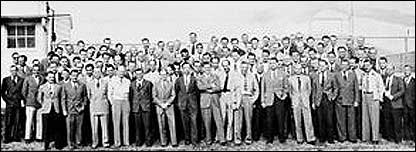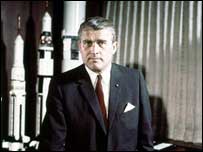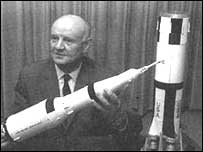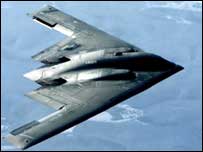Untitled Document

Sixty years ago the US hired Nazi scientists to lead pioneering projects,
such as the race to conquer space. These men provided the US with cutting-edge
technology which still leads the way today, but at a cost.
The end of World War II saw an intense scramble for Nazi Germany's many technological
secrets. The Allies vied to plunder as much equipment and expertise as possible
from the rubble of the Thousand Year Reich for themselves, while preventing
others from doing the same.
The range of Germany's technical achievement astounded Allied scientific intelligence
experts accompanying the invading forces in 1945.
 |
Wernher von Braun: Nasa icon
and former SS officer |
Supersonic rockets, nerve gas, jet aircraft, guided missiles, stealth technology
and hardened armour were just some of the groundbreaking technologies developed
in Nazi laboratories, workshops and factories, even as Germany was losing the
war.
And it was the US and the Soviet Union which, in the first days of the Cold
War, found themselves in a race against time to uncover Hitler's scientific
secrets.
In May 1945, Stalin's legions secured the atomic research labs at the prestigious
Kaiser Wilhelm Institute in the suburbs of Berlin, giving their master the kernel
of what would become the vast Soviet nuclear arsenal.
US forces removed V-2 missiles from the vast Nordhausen complex, built under
the Harz Mountains in central Germany, just before the Soviets took over the
factory, in what would become their area of occupation. And the team which had
built the V-2, led by Wernher von Braun, also fell into American hands.
Crimes
Shortly afterwards Major-General Hugh Knerr, deputy commander of the US Air
Force in Europe, wrote: "Occupation of German scientific and industrial
establishments has revealed the fact that we have been alarmingly backward in
many fields of research.
"If we do not take the opportunity to seize the apparatus and the brains
that developed it and put the combination back to work promptly, we will remain
several years behind while we attempt to cover a field already exploited."
Thus began Project Paperclip, the US operation which saw von Braun and more
than 700 others spirited out of Germany from under the noses of the US's allies.
Its aim was simple: "To exploit German scientists for American research
and to deny these intellectual resources to the Soviet Union."
 |
Arthur Rudolph: "100% Nazi" |
Events moved rapidly. President Truman authorised Paperclip in August 1945 and,
on 18 November, the first Germans reached America.
There was, though, one major problem. Truman had expressly ordered that anyone
found "to have been a member of the Nazi party and more than a nominal
participant in its activities, or an active supporter of Nazism militarism"
would be excluded.
Under this criterion even von Braun himself, the man who masterminded
the Moon shots, would have been ineligible to serve the US. A member of numerous
Nazi organisations, he also held rank in the SS. His initial intelligence file
described him as "a security risk".
And von Braun's associates included:
Arthur Rudolph, chief operations director at Nordhausen,
where 20,000 slave labourers died producing V-2 missiles. Led the team which
built the Saturn V rocket. Described as "100 per cent Nazi, dangerous
type".
Kurt Debus, rocket launch specialist, another SS officer.
His report stated: "He should be interned as a menace to the security
of the Allied Forces."
Hubertus Strughold, later called "the father of space
medicine", designed Nasa's on-board life-support systems. Some of his
subordinates conducted human "experiments" at Dachau and Auschwitz,
where inmates were frozen and put into low-pressure chambers, often dying
in the process.
All of these men were cleared to work for the US, their alleged crimes covered
up and their backgrounds bleached by a military which saw winning the Cold War,
and not upholding justice, as its first priority.
And the paperclip which secured their new details in their personnel files
gave the whole operation its name. Sixty years on, the legacy of Paperclip remains
as vital as ever.
With its radar-absorbing carbon impregnated plywood skin and swept-back single
wing, the 1944 Horten Ho 229 was arguably the first stealth aircraft.
 |
The Stealth bomber: Based on a 1944 German design |
The US military made one available to Northrop Aviation, the company which would
produce the $2bn B-2 Stealth bomber - to all intents and purposes a modern clone
of the Horten - a generation later.
Cruise missiles are still based on the design of the V-1 missile and the scramjets
powering Nasa's state-of-the-art X-43 hypersonic aircraft owe much to German
jet pioneers.
Added to this, the large number of still-secret Paperclip documents has led
many people, including Nick Cook, Aerospace Consultant at Jane's Defence Weekly,
to speculate that the US may have developed even more advanced Nazi technology,
including anti-gravity devices, a potential source of vast amounts of free energy.
Cook says that such technology "could be so destructive that it would
endanger world peace and the US decided to keep it secret for a long time".
But, while celebrating the undoubted success of Project Paperclip, many will
prefer to remember the thousands who died to send mankind into space.

